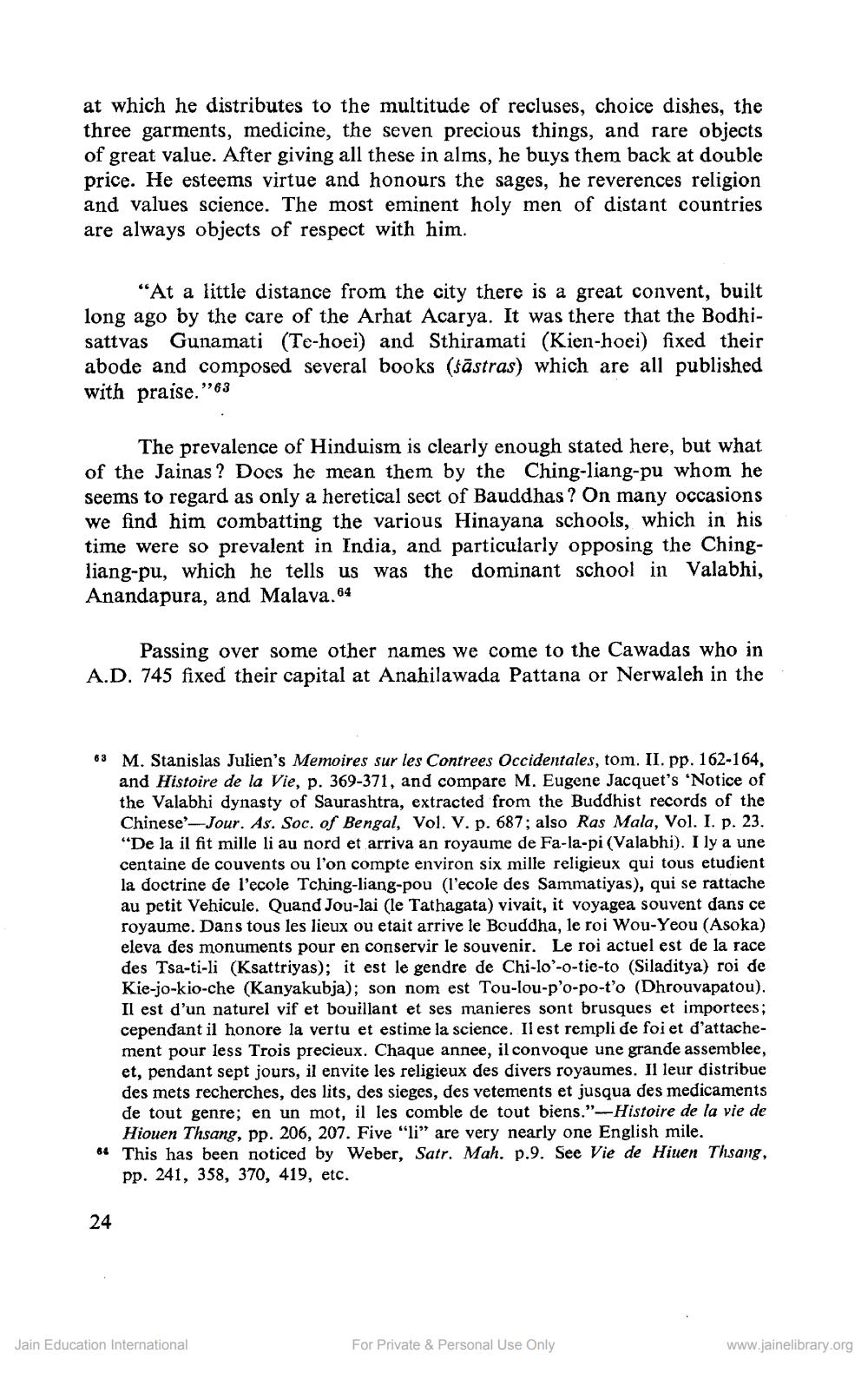________________
at which he distributes to the multitude of recluses, choice dishes, the three garments, medicine, the seven precious things, and rare objects of great value. After giving all these in alms, he buys them back at double price. He esteems virtue and honours the sages, he reverences religion and values science. The most eminent holy men of distant countries are always objects of respect with him.
"At a little distance from the city there is a great convent, built long ago by the care of the Arhat Acarya. It was there that the Bodhisattvas Gunamati (Te-hoei) and Sthiramati (Kien-hoei) fixed their abode and composed several books (sāstras) which are all published with praise."63
The prevalence of Hinduism is clearly enough stated here, but what of the Jainas? Does he mean them by the Ching-liang-pu whom he seems to regard as only a heretical sect of Bauddhas? On many occasions we find him combatting the various Hinayana schools, which in his time were so prevalent in India, and particularly opposing the Chingliang-pu, which he tells us was the dominant school in Valabhi, Anandapura, and Malava.64
Passing over some other names we come to the Cawadas who in A.D. 745 fixed their capital at Anahilawada Pattana or Nerwaleh in the
63
24
M. Stanislas Julien's Memoires sur les Contrees Occidentales, tom. II. pp. 162-164, and Histoire de la Vie, p. 369-371, and compare M. Eugene Jacquet's 'Notice of the Valabhi dynasty of Saurashtra, extracted from the Buddhist records of the Chinese-Jour. As. Soc. of Bengal, Vol. V. p. 687; also Ras Mala, Vol. I. p. 23. "De la il fit mille li au nord et arriva an royaume de Fa-la-pi (Valabhi). I ly a une centaine de couvents ou l'on compte environ six mille religieux qui tous etudient la doctrine de l'ecole Tching-liang-pou (l'ecole des Sammatiyas), qui se rattache au petit Vehicule. Quand Jou-lai (le Tathagata) vivait, it voyagea souvent dans ce royaume. Dans tous les lieux ou etait arrive le Bouddha, le roi Wou-Yeou (Asoka) eleva des monuments pour en conservir le souvenir. Le roi actuel est de la race des Tsa-ti-li (Ksattriyas); it est le gendre de Chi-lo'-o-tie-to (Siladitya) roi de Kie-jo-kio-che (Kanyakubja); son nom est Tou-lou-p'o-po-t'o (Dhrouvapatou). Il est d'un naturel vif et bouillant et ses manieres sont brusques et importees; cependant il honore la vertu et estime la science. Il est rempli de foi et d'attachement pour less Trois precieux. Chaque annee, il convoque une grande assemblee, et, pendant sept jours, il envite les religieux des divers royaumes. Il leur distribue des mets recherches, des lits, des sieges, des vetements et jusqua des medicaments de tout genre; en un mot, il les comble de tout biens."-Histoire de la vie de Hiouen Thsang, pp. 206, 207. Five "li" are very nearly one English mile. This has been noticed by Weber, Satr. Mah. p.9. See Vie de Hiuen Thsang, pp. 241, 358, 370, 419, etc.
Jain Education International
For Private & Personal Use Only
www.jainelibrary.org




